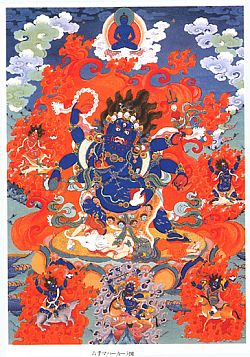A symbolic decent into the absolute darkness of the transcendental spirit

The darkness is an ambivalent symbol which can be described at three levels:
I. At the personal level, it represents a negation of the entire known world. It inspires fear and because of this, the darkness is commonly associated with the negative. Thus, from a limited point of view, darkness means ‘bad’ or even demonic.
II. Psychology has investigated this domain of darkness extensively. It does not necessarily consider it negative. On the psychological plane it corresponds to the indeterminacy of childhood and to the undifferentiated state of death and the decomposition of the personality.
The depths of the abyss form an analogy with the kingdom of the dead and hence the worship of the Great Goddess, Mother Earth. When C. G. Jung connects the symbolism of the abyss to his maternal archetype, the mother who inspires both, love and fear, it was upon the basis of this age-old cultural substratum. Similarly, for Hindus, Mother Kali evokes fear in the ignorant and love in the devoted.
In Hindu, Chinese, and Japanese traditions black is the color of the universal substance (prakriti), of Materia prima, of primordial formlessness, of chaos at the beginning of time, of the north and of death. In this sense, black has an aspect of impurity, yet conversely, it is an expression of primordial ‘virginity’ as in the symbolism of medieval Black Madonnas. Kali is black because she returns us to the state of formlessness and of diffused shapes and colors.
Darkness, as Jung had emphasized, is the place of germination, the period during which seeds germinate before they burst into life and light.
III. But from an even deeper perspective, darkness also indicates the ultimate act of unification, the so-called mystical marriage. The abyss is as much topless as bottomless. The darkness is associated with the total disappearance of the rational mind. The subconscious concept of night suggests ’emptiness’ or ‘nakedness’ that purifies the mind, eliminating ‘dryness’ or ‘aridity’ of rational thinking, thus bringing sacred longings, sensual emotions and even the highest aspirations.
Deprived of light, the individual is dispossessed of all. This is the so-called doctrine of privato boni. From a transcendent point of view, darkness is the symbol of the ‘Supreme Identity’, the true origin of the ‘Light of the World’, which remains invisible to the eyes of man.
In the darkness retreat, as in deep sleep, the whole objective world disappears.
“If you can love darkness, you will become unafraid of death. If you can enter into darkness – and you can enter when there is no fear – you will achieve total relaxation. If you can become one with darkness, you are dissolved, it is a surrender. Now there is no fear, because if you have become one with darkness, you have become one with death. You cannot die now, you have become deathless. Darkness is deathless. Light is born and dies. Darkness simply is. It is deathless.” – Sri Osho Rajneesh
